Fujifilm X-H1 Review
Fujifilm X-H1 Introduction
The Fujifilm X-H1 was released in early 2017 as a follow up to the highly-acclaimed X-T10 with an upgraded imaging pipeline. It sports the next generation 24 megapixels X-Trans CMOS III sensor and X Processor Pro, replacing the 16 megapixels X-Trans CMOS II and EXR II processor of the X-T10. One generation difference provides it with 50% more megapixels while keeping the same full ISO 100-51200 sensitivity range and increasing Phase-Detect points from 77 to 325.
The new X Processor Pro and hybrid shutter allows the X-H1 to continuous capture full-resolution images at 14 FPS. An upgraded buffer allows for 42 JPEG images or 23 RAW files per burst. This is a significant improvement over the X-T10's 8 FPS drive that only managed 8 frames, regardless of format. The shutter-speed range remains the same though at 1/32000-30s, plus Bulb exposures of up to an hour.
The highly-mechanical design of the X-H1 blends analog and digital controls in an elegant and sturdy metal body. It offers direct dials for EC, Shutter-Speed and Drive-Mode, plus dual control-dials which give efficient access to all essential photography controls.
The new X-H1 is externally identical to its predecessor. It offers the same 0.39" EVF with 2.4 megapixels, 100% coverage, 0.62X magnification and an extremely useful Eye-Start sensor. As the mid-range offering among Fujifilm mirrorless, the X-H1 is not weatherproof or freezeproof.
The X-H1 uses Fuji's own XF lens mount which has a very short flange distance. This makes it easier to design high-quality lenses and lens-mount adaptors, including one made by Fuji for the Leica M-mount. Fuji launched a total of 20 lenses by now. Plus, there are third-party lenses from Zeiss and Samyang now, plenty of options, besides long telephoto lenses.
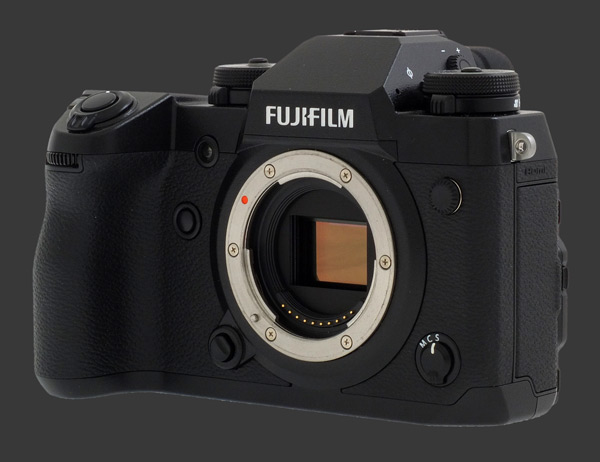
This digital camera review analyses the performance and image quality of the Fuji X-H1.
Fuji X-H1 Features
Sensor
- 24 Megapixels CMOS sensor
- X-Trans 6x6 Color-Filter Array
- No Anti-Alias filter
- 1.5X Crop factor (APS-C)
- 3:2 Aspect ratio
- Phase-Detect AF
- Built-in 5-Axis Image-Stabilization
- Fuji XF lens mount
- Dust-Reduction
Exposure
- ISO 200 to 12800 sensitivity range, 1/3 EV steps
- ISO 100, 25600 & 51200 expansion
- Auto ISO, Selectable maximum from 400 to 12800
- ISO Bracketing, 3 frames, 1/3-1 EV steps
- Hybrid Shutter, 1/3 EV steps:
- Mechanical: 1/4000s-30s Shutter-Speeds
- Electronic: 1/32000-30s, ISO 200-12800 Only
- EFCS: 1/32000-30s, ISO 200-12800 Only
- 1/32000-30s Shutter-speeds, 1/3 EV steps
- Bulb exposure, maximum 1 hour
- PASM Exposure modes
- Multi-Segment, Center-Weighed, Spot and Average metering
- Exposure-Compensation, ±5, 1/3 EV steps
- AEB, 2-9 frames, 1/3-3 EV increments
- 100%, 200% or 400% Dynamic-Range
- Flash-Compensation, ±2, 1/3 EV steps
- On, Slow, Manual, Wireless or Off Flash Modes
- Rear or Front Curtain Sync
- Optional Redeye Removal
Image Parameters
- Automatic, 7 presetsSunny, Shade, 3 Fluorescents, Incandescent, Underwater, Kelvin and Custom WB
- WB fine-tuning along 2 axis in 19 steps
- WB Bracketing, 3 frames, 3 step sizes
- Film Simulation: Provia, Velvia, Astia, Classic Chrome, Pro Negative Hi, Pro Negative, Eterna, Across B&W plus 3 filters, Standard B&W plus 3 optional filters, Sepia
- Film Simulation Bracketing, 3 frames
- Dynamic Range Priority
- Adjustable Highlight & Shadow Tone, 7 steps each
- Adjustable Color, Sharpness and Noise reduction, 9 steps each
- Optional Long Exposure Noise Reduction
- Optional Lens Modulation Optimizer
- Optional Grain Effect, 2 levels
Output Processing
- 3:2 Native aspect ratio
- 16:9 and 1:1 cropped aspect ratios
- 24, 12 and 6 megapixels modes
- JPEG, RAW, RAW+JPEG capture
- 2 JPEG Compression levels
- Optional Lossless RAW Compression
Focus
- Hybrid 325-Point AF system
- Single-Shot AF, Continuous AF, DMF or MF
- Point AF Selection, 325-Points, 5 sizes
- Zone AF Selection, 91 areas, 3 sizes
- Wide Tracking AF-C, 5 settings
- Optional Prefocus
- Optional Face/Eye Detection
- Optional Electronic Magnification
- Optional Digital Split Image
- Optional Focus Peaking
- Optional AF-Assist lamp
- Optional Touch AF
- Fly-By-Wire focus-ring on most lenses
Drive
- 14 FPS Electronic-Shutter Continuous Drive, 40 JPEG or 27 RAW
- 8 FPS Mechanical-Shutter Continuous Drive, 80 JPEG or 31 RAW
- 6 FPS Electronic Front-Curtain Shutter Continuous Drive, Unlimited JPEG or 31 RAW
- 11 FPS Mechanical-Shutter Continuous Drive, 70 JPEG or 28 RAW, with VPB-XH1 Grip
- Motion Panorama, Normal or Wide, 4 Directions
- Interval Timer, 1s-24h interval, 1-999 or Infinite frames, 0m-24h delay
- Multiple-Exposure, 2 frames
- Self-timer, 2s or 10s
Video
- 4096x2160 @ 24 FPS Cinema 4K
- 3840x2160 @ 30 FPS 4K Ultra-HD
- 2048x1080 @ 24 FPS Cinema HD
- 1920x1080 @ 60 FPS 1080p Full-HD
- 1920x1080 @ 120 FPS 1080p Full-HD
- Area or Auto AF Selection
- MPEG-4 Codec or HDMI Output
- Built-in Stereo Microphone, 36 levels
- Mini-Jack Stereo Audio Input, 36 levels
- Configurable Tally Lights
- Optional Audio Level Limiter
- Optional Low-Cut Filter
- Optional Wind-Filter
- Optional Time-Code
- Optional F-Log Output
Display & Viewfinder
- 0.5" EVF
- 3.7 Megapixels
- 0.75X Magnification
- 100% Coverage
- Eye-Start sensor
- 3" Double-Hinge Tilting LCD
- 1 Megapixel
- Touchscreen
- Digital Level, 2-axis
- Depth-Of-Field Preview
- Depth-Of-Field Scale
- E-Ink Status Display
- Optional Live-Histogram
- Optional Framing-Guides, 3 types
Misc
- Dual control-dials
- Customizable Control-Dials
- Shutter-speed dial, full-stops only
- ISO Dial, 1/3-stops for standard range
- Aperture ring on most lenses
- 8-Way Focus Joystick
- 8 Customizable Buttons
- Dual SDXC UHS-II Slots
- Wired-Remote connector
- Standard Hot-Shoe
- 4K HDMI output
- USB 3.0 port
- Built-in WiFi
- Bluetooth 4.1 LE
- Lithium-Ion battery
Specifications highlighted in green above differ from the X-T2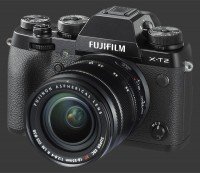
Fujifilm X-T2 which shares a similar design and feature-set.
Fujifilm X-H1 Capability - What can it do?
The Fujifilm X-H1 is an incredibly feature-rich mirrorless, particularly when it comes to video. The headline new feature though is a built-in image-stabilization system which makes its first appearance inside a Fujifilm mirrorless. This is a state-of-the-art 5-axis image-stabilization system officially effective to 5.5-stops over hand-holding. Not only does the X-H1 take on every feature of the previous X-T2
Fujifilm X-T2 flagship, it augments many of them with more latitude.
This camera offers a hybrid shutter which operates in Mechanical-Shutter, Electronic-Shutter and Electronic Front-Curtain-Shutter modes. Users can now select any combination of these which sets the range of allowable shutter-speeds. Mechanical speeds reach 1/8000s, while electronic ones reach 1/32000s. There are 3 Auto ISO settings, all customizable with a starting and maximum ISO, plus a minimum shutter-speed. Otherwise, ISO can be manually set from 200-12800 in 1/3 steps. Expanded ISO 100, 25600 and 51200 sensitivities are also available, now usable in all shutter-modes.
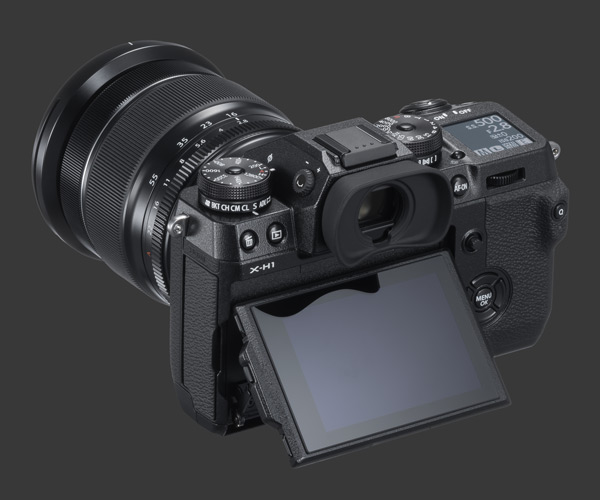
As one would expect, the X-H1 has a full complement of manual controls. There are four metering patterns, one more than usual: Multi-Segment, Center-Weight, Average and Spot. White-Balance options are plentiful with Auto, Preset and Custom options, all fine-tunable in 19 steps along 2 axis. A Virtual Bracketing option saves 3 images with different WB adjustments with 3 step sizes to choose from along the Y-B axis.
Fujifilm has its own rendering engine based around Film Simulation mode with a number of parameters to adjust JPEG output as desired. Color, Sharpness and Noise-Reduction are each adjustable in 9 fine steps while Shadow-Tone and Highlight-Tone have 7 very coarse steps. None of these affect RAW output. For the unsure, there is a virtual bracketing mode for Film Simulation which takes one shot and saves it using 3 different Film Simulation modes chosen by the user. The X-H1 adds a tenth Film Simulation mode, Eterna, to the already long-list available in previous Fujifilm mirrorless.
The X-H1 offers a huge number of Bracketing modes. AEB, ISO, Film Simulation, WB and Dynamic-Range. There are so many AEB options that the menu now reaches seven levels of depth. It can capture between 2 and 9 frames with steps from 1/3 to 3 EV selectable in 1/3 increments regardless of how many frames are selected. A bracket can be taken continuously or in single-shots and there are four ordering to choose from. Clearly, no other digital camera offers this level of flexibility.
Drive modes include a standard 2s or 10s Self-Timers, plus an Interval Timer which can capture as many frames as will fit on a memory card. Users can select any interval from 1s to a full day and a starting delay of up to 24 hours in one minute increments. Multiple-Exposure can combine two frames. Notably absent from this and other Fujifilm mirrorless cameras is built-in HDR capture.
Continuous shooting is possible from 3 to 14 FPS. The mechanical shutter can handle up to 8 FPS with the camera alone or 11 FPS when using the optional battery-grip in Boost mode. The buffer depth varies with speed, getting longer for slower frame-rates, as usual. At 14 FPS, 40 JPEG images or 27 RAW files are possible in a single burst. By 6 FPS, the number of JPEGs that can be captured in a single burst is only limited by the space available. This mirrorless makes use of its continuous drive and hybrid shutter to offer a Motion Panorama mode. This one creates a panoramic image of 180° or 120° while the camera is physically panned in any of the 4 cardinal directions.

This is the first Fujifilm mirrorless to offer Dual SDXC memory card slots, both capable of handing UHS-II cards. The slots can be used in overflow, backup and format-separate modes. Fujifilm thoughtfully allows the JPEG and RAW files to be deleted simultaneously from both cards but, sadly, not two files of the same format. Hopefully this glaring omission can be rectified via a firmware update.
Movie features of the Fujifilm X-H1 reach a whole new level. It is the only APS-C mirrorless capable of recording extra-wide video, both in Cinema 4K and Cinema HD which corresponds to 4096x2160 and 2048x1080 resolutions. In these modes, the frame-rate is limited to 24 FPS. When using standard 4K, the X-H1 can film at 30 FPS and 1080p is possible at up to 120 FPS. Cinema 4K and Ultra-HD 4K offer a maximum bit-rate of 200 Mbps, while Cinema HD and 1080p top at 100 Mbps.
There are tons of controls over audio, including 36-levels of gain for both external and internal microphones. A Level Limiter, Wind Filter and Low-Cut Filter can be each enabled independently. There are a number of settings for Time-Code plus control over lights which show that the camera is recording.
With all these features and plenty of external controls, the Fujifilm X-H1 is capable of any type of photography when paired with the right lens. There are currently over 40 lenses made for the X-mount, most of them by Fujifilm themselves. Rectilinear lenses cover focal-lengths from 10 to 400mm. There are no bright telephoto lenses though and so wildlife and some types of sports photography are out-of-reach from all Fujifilm mirrorless cameras. The Fujifilm X-H1 is fairly well suited to low-light photography for a mirrorless. It offers metered exposures of 30s and Bulb exposures of up to an hour.
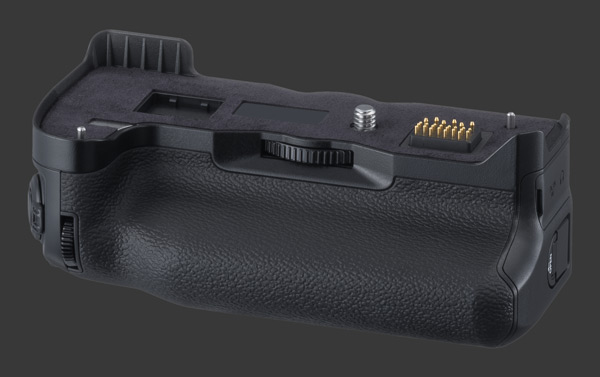
Speed is a major performance aspect of the X-H1 and it is sufficiently fast to capture action thanks to a state-of-the-art 325-Point Hybrid Phase-Detect and Contrast-Detect AF system plus a 14 FPS continuous drive. With a maximum shutter-speed of 1/32000s, this mirrorless can freeze almost any action. Crucially, the large and bright EVF built into the X-H1 keeps up very well with action with virtually no blackout and a 100 FPS refresh-rate.
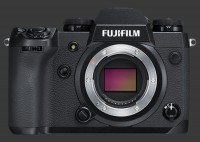 |
Please Support Neocamera
All information on Neocamera is provided free of charge yet running this website is a huge endeavor. Purchases made via affiliate links found throughout the site help keep it running and up-to-date. There is no additional cost to you, so please consider buying via these links to our affilates:
If you found any information on this site valuable and did not purchase via our affiliate links, please considering donating via PayPal:
Any amount will be greatly appreaciated. Thank you for your support!
Fujifilm X-H1 Highlights

Sensor-Size: 24 x 16mm

Actual size when viewed at 100 DPI
| 24 Megapixels Mirrorless | ISO 100-51200 |
| Fujifilm X Mount 1.5X FLM | Shutter 1/32000-30s |
| 5-Axis Built-in Stabilization, 5.5-Stop Improvement | Full manual controls, including Manual Focus |
| 0.50" Built-in EVF 3.7 Megapixels (0.75X) | Custom white-balance with 2 axis fine-tuning |
| Automatic Eye-Start sensor | Spot-Metering |
| 2 Axis Digital Level | Hot-Shoe & Sync-Port |
| Weatherproof down to -10C | Stereo audio input |
| Built-in Dust Reduction | Lithium-Ion Battery |
| 14 FPS Drive, 40 Images | Secure Digital Extended Capacity x 2 |
| 4096x2160 @ 24 FPS Video Recording | |
| 3" LCD 1 Megapixels |
Updates
2025.01.18

Fujifilm GFX 2025 Lens Roundup
Lens Review roundup of Fujifilm GFX Medium-Format lenses. Quality, performance and handling of the GF20-35mm F/4R WR, GF30mm F/3.5 Tilt-Shift and the GF55mm F/1.7.
2024.11.18

Best 2024 Photography Gifts for Every Budget
Great gifts for photographers and photo enthusiasts selected for every budget among the best products of 2024.
2024.08.07

Eye Protection Tips for Professional Photographers
The four main considerations for professional photographers regarding eyewear.
2024.07.14

Fujifilm X100VI Review
Flagship fixed-lens compact digital camera with a 40 MP sensor and Image-Stabilization, a first for the series. Retro design featuring dual control-dials, plus direct ISO, Shutter-Speed and EC dials. Its hybrid viewfinder can switch between EVF and OVF mode.
2024.05.09

Fujifilm GFX100 II Review
Flagship 102 Megapixels Medium-Format Mirrorless Digital Camera with 8-Stop 5-Axis IBIS, 8 FPS Drive, 8K Video and 400 MP Super-Resolution capture in a weatherproof and freezeproof body with dual control-dials and dual memory-card slots.
2024.04.03

Fujifilm X-T5 Review
Newest Fujifilm flagship boasting a 40 MP APS-C sensor, 5-axis IBIS with 7-stop efficiency, 15 FPS continuous drive, 6.2K Video capture, dual control-dials and dual SDXC UHS-II slots in a sturdy weatherproof and freezeproof body.
2023.11.20

Best Digital Cameras of 2023
Find out which are the Best Digital Cameras of 2023. All the new Mirrorless Digital Cameras from entry-level to high-end professional.
2023.07.10

Fujifilm X-H2 Review
40 Megapixels APS-C Hybrid Mirrorless Digital Camera with 7-stop IBIS. Fastest shutter ever and 8K video capture. Large builtin EVF with 0.8X magnification and 5.8 MP, plus an Eye-Start Sensor. Packed with features and large number of controls in a weatherproof and freezeproof body.
2023.05.07

Sony FE 20-70mm F/4G Review
Review of the unique Sony FE 20-70mm F/4G lens. The optical zoom of this lens spans ultra-wide-angle and medium focal-length coverage, making it one of the most versatile Full-Frame lenses on the market.
2023.01.15

Huion Inspiroy Dial 2 Review
Review of the Huion Inspiroy Dial 2 tablet, a medium sized drawing surface with dual dials and customizable buttons. Connects via USB-C or Bluetooth 5.0 with Windows, Linux and Android support.
2022.12.08

How to Pack for a Photo Trip
Find out how to pack for a travel photography trip, carry your gear safely while meeting airline regulations.
2022.11.13

Best Digital Cameras of 2022
The best digital cameras of 2022. A short list of the most outstanding models in their respective categories. Choose one for yourself or as a gift.












